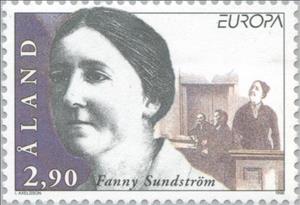Stamp: C.E.P.T. - Famous women - Fanny Sundström (Åland Islands 1996)
C.E.P.T. - Famous women - Fanny Sundström (Åland Islands 1996)
06 May (Åland Islands ) within release C.E.P.T.- Famous women goes into circulation Stamp C.E.P.T. - Famous women - Fanny Sundström face value 2.90 Finnish markka
| Stamp C.E.P.T. - Famous women - Fanny Sundström in catalogues | |
|---|---|
| Michel: | Mi:AX 114 |
Stamp is horizontal format.
Also in the issue C.E.P.T.- Famous women:
- Stamp - C.E.P.T. - Famous women - Sally Salminen face value 2.80;
- Stamp - C.E.P.T. - Famous women - Fanny Sundström face value 2.90;
Stamp C.E.P.T. - Famous women - Fanny Sundström it reflects the thematic directions:
Famous People refers to the fame and public attention accorded by the mass media to individuals or groups or, occasionally, animals, but is usually applied to the persons or groups of people (celebrity couples, families, etc.) themselves who receive such a status of fame and attention. Celebrity status is often associated with wealth (commonly referred to as fame and fortune), while fame often provides opportunities to make money.
The mail or post is a system for physically transporting documents and other small packages; or, the postcards, letters, and parcels themselves. A postal service can be private or public, though many governments place restrictions on private systems. Since the mid-19th century national postal systems have generally been established as government monopolies with a fee on the article prepaid. Proof of payment is often in the form of adhesive postage stamps, but postage meters are also used for bulk mailing. Modern private postal systems are typically distinguished from national postal agencies by the names "courier" or "delivery service". Postal authorities often have functions other than transporting letters. In some countries, a postal, telegraph and telephone (PTT) service oversees the postal system, in addition to telephone and telegraph systems. Some countries' postal systems allow for savings accounts and handle applications for passports.
The European Conference of Postal and Telecommunications Administrations (CEPT) was established on June 26, 1959, as a coordinating body for European state telecommunications and postal organizations. The acronym comes from the French version of its name Conférence européenne des administrations des postes et des télécommunications.
The Europa postage stamp (also known as Europa - CEPT until 1992) is an annual joint issue of stamps with a common design or theme by postal administrations of member countries of the European Communities (1956-1959), the European Conference of Postal and Telecommunications Administrations (CEPT) from 1960 to 1992, and the PostEurop Association since 1993. Europe is the central theme. EUROPA stamps underlines cooperation in the posts domain, taking into account promotion of philately. They also build awareness of the common roots, culture and history of Europe and its common goals. As such, EUROPA stamp issues are among the most collected and most popular stamps in the world. Since the first issue in 1956, EUROPA stamps have been a tangible symbol of Europe’s desire for closer integration and cooperation.





